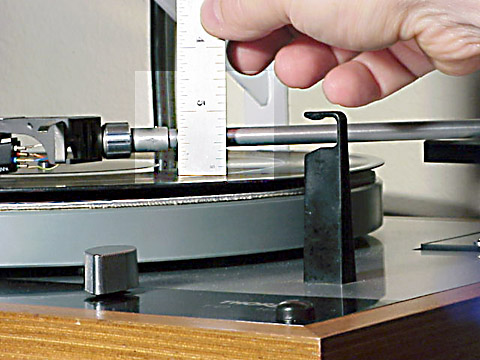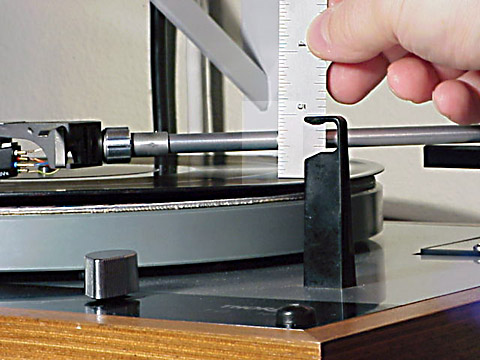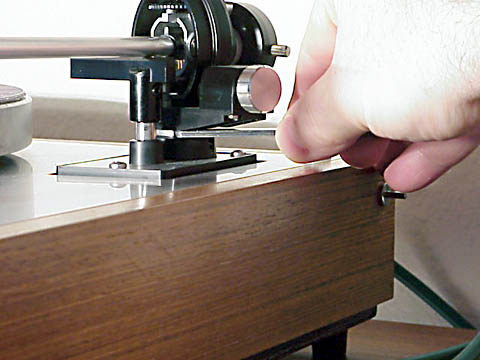-edible zone-

Vertical Tracking Angle (VTA) describes the angle between a line,
from cantilever pivot to stylus contact area, and the record surface.
While this angle is manufactured into the cartridge, VTA will require
setting when installing the phono cartridge to a tonearm. On a pivoting
tonearm, such as the Thorens TP16 in use below, a final VTA setting may
be arrived at by raising or lowering the tonearm at it's base mounting.
Raising the entire tonearm will increase VTA, lowering will decrease VTA.
Conversely, raising or lowering the vertical position of the stylus as
it rides the groove will have the same effect as raising or lowering at
the pivot end. Different thickness records or platter mats can alter VTA.
And... it is presumed you have no plans to add shims between cartridge
and headshell. So we focus on making the vta/sra adjustment by
moving the base mount at the axis end up or down.
Arriving at the correct VTA may or may not seem to be a simple
matter. In a perfect world, where every record is perfectly flat and is
cut on a machine that conforms to the same exact VTA standard, and every
record is exactly the same thickness. VTA would only have to be set
once. I don't know about your world, but in mine records come in varying
thickness' and are often slightly warped. To make matters worse, some
records have had their masters cut at a slightly different Vertical
Tracking Angle.
Setting VTA on a Thorens TD160 with TP16 tonearm.
This
procedure makes the assumption that all other tonearm adjustments have
been made previously. VTA should be in the ball park when making the
other tonearm alignments. If VTA has been altered by a large amount, it
could prove useful to double check your overhang setting with a
protractor just to be certain that this has not been altered. Small
amounts will be of no consequence. Another cautionary note; changing VTA
by large amounts to accommodate taller platter mats will also require a
similar height adjustment for the standard cue bar of the TP16 and TP11
tonearms. See photo #6 at bottom.
A practical approach, for those
who wish to set VTA only once, is to choose the median thickness record
with a median amount of warp and use this as your listening test mule
for setting VTA by eye and ear. Initial setting will be to get the
bottom edge of the arm tube closely parallel to the record surface. As
seen in photos 1 and 2, with stylus resting stationary in the record
groove, arm tube is the same 7/16 inches off the record surface measured
at two points with some distance between them along the arm tube. This
can be a starting point for the adjustments by ear. ( BTW, your distance
does not have to be 7/16. This will vary according to cartridge height
and mounting shims, etc. It just needs to be the same distance measured
from two points.)
For adjustment by ear I like to sacrifice a
favored album that is typical of the music most listened to. As noted
above, this record will be of a median thickness from the record
collection. I will listen to various tracks of this album repeatedly as
adjustments are made. Naturally, this will induce accelerated wear into
the record. This is one reason I have multiple copies of favorite
albums. Adjustment increments can be precisely made using methods
illustrated in photos 3, 4 and 5. When searching for the "ballpark" I
will make incremental adjustments of .02 inches. When I think my sound
is in the ballpark and needs a closer fine tuning, this increment is
reduced to .005 inches. All this is determined in the stack-up of feeler
gages shown below and a given setting can be repeated at will. Take
notes of your feeler gage stack-up values that work and those that
don't.
What am I listening for...? The fullest, most alive sound.
In general, when VTA is too great (arm base too high) the sound will go
hard and metallic, when too small (arm base too low) sound will go
lifeless and lack detail.
1)

2)

3)

A measured stack-up of feeler gages fills the gap between the arm board and the bottom of the anti-skate fixture at the tonearm base. One hand holds the gages while the other hand tightens the screw. There is a certain element of 'feel' involved in terms of a tight or loose fit. I want to feel a bit of drag on the stack-up of feeler gages as I push them into this gap.
4)

Two allen set screws hold the tonearm in place. The first set screw is shown in photo 4. The next set screw is 90 degrees to the back. Size of allen wrench is 2mm. Remember to park the tonearm in the rest before your start this. Once the screws are loose, the entire tonearm may be raised or lowered. I prefer to hold onto the upper portion of the gimbal frame to lift and lower the tonearm. Place your stack-up of feeler gages in the gap and then lower the tonearm onto it. Caution; don't attempt to remove the tonearm or you may damage the fragile tonearm wires which are soldered to a ter minal inside the box. There is no recommended torque value for the set screws so I use the small end of the wrench to tighten the screw (less leverage). This keeps me from over-tightening.
5)

Here is the gap after setting. The actual surfaces that register this
fit are narrow but give the most repeatable location for this adjustment
on this tonearm.* I like to record my gap distances for a given
turntable mat that I happen to be trying out. This way I can easily
return the tonearm height to a previous setting.
*other tonearms
may have a different, more suitable location for these measurements.
6)

If you raise or lower the tonearm by very much, it will also be necessary to adjust the height of your cue bar. A single set screw holds it to the shaft. Release the set screw and slide the bar up or down. The bar should clear the arm tube when parked but hold the stylus above the record surface by a comfortable height margin. This height margin may be set according to your preference.